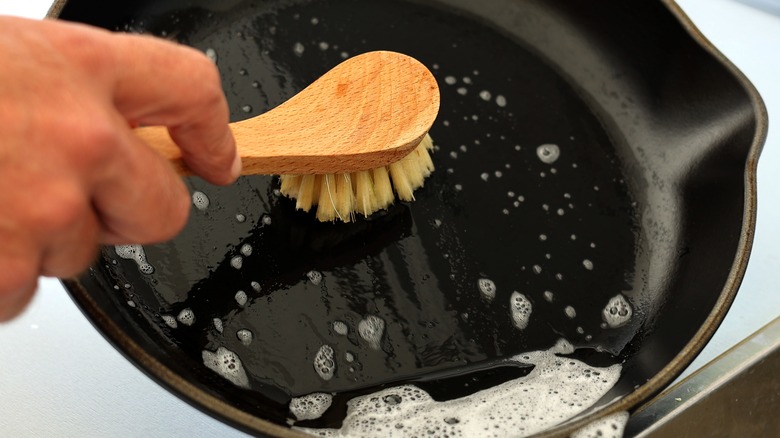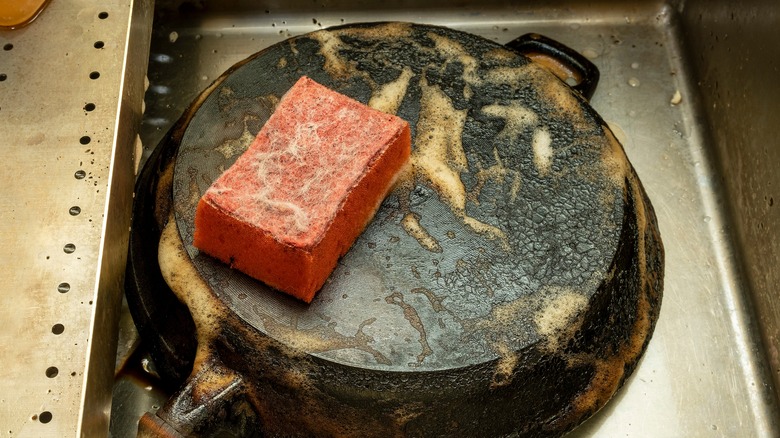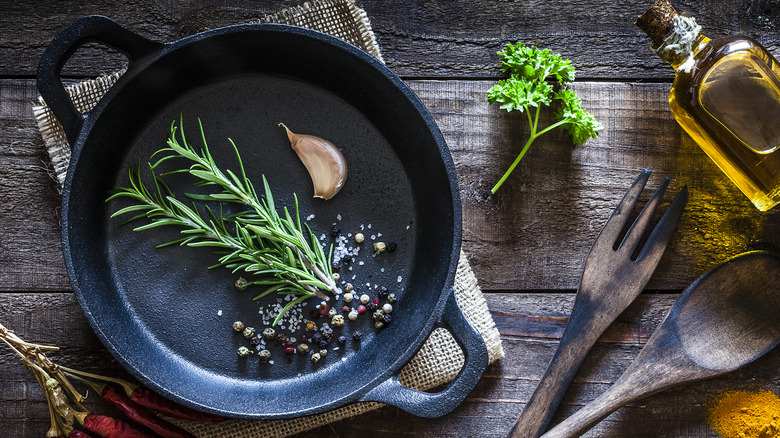How To Clean A Cast Iron Pan, The Short Way And The Long Way
Cast iron pans have stood the test of time for good reason. On top of being extremely sturdy and long-lasting, these skillets are incredibly versatile. You can cook with them on the grill, the oven, and most stovetops. While these classic pans retain heat wonderfully and perfectly crisp up foods from frozen pizza to burgers, many home cooks are intimidated by cast iron due to the upkeep that it requires. There are two ways to keep your cast iron pans in pristine condition, and one will only take a few minutes out of your day.
The quickest method to clean your cast iron only requires a simple wash with water, a scrubbing tool such as a sponge or non-abrasive brush, and unscented dish detergent that isn't too harsh. This approach works when you're not dealing with stubborn burn marks or rust in your pan, as it only gets rid of grime from everyday use.
Meanwhile, the lengthier way to clean cast iron requires you to submerge your pan in a 50/50 mixture of water and distilled white vinegar — which is perfect if you're buying a pan secondhand and really need to give it a deep clean. You can leave your cookware in this solution for an hour or two, but any longer than a day can result in permanent damage, so make sure to move on to the next steps before then.
After a good soak, gently scrub your pan
Once your pan has sat in the vinegar water mix for long enough, you'll want to put on a pair of rubber gloves to prepare for the rest of the vigorous cleaning routine. Remove the pan from the solution and scrub off any remaining gunk with a kitchen brush under running water. Most of the grime should come off easily, but you can also use stainless steel wool if you're still having trouble removing any dirty spots. Just be very careful, as abrasive cleaning tools are usually not preferred for cast iron, since they can damage the pan's seasoned coating.
You'll also want to be quick when scrubbing the pan, as rust can quickly appear on your skillet's surface right after you remove it from the vinegar and water mixture. If you run into this problem, you can use a mild oxalic acid cleanser to dispose of any rust. That way, you won't have to soak your cast iron for yet another extended period of time again. The care process doesn't end with this final scrub, either. You'll have to do some finishing touches on your skillet to make sure it stays in good condition.
Keep rust from forming in your cast iron pan by drying and reseasoning
Whether you're doing a short or long wash, leftover water on your pan should be your biggest worry when it comes to cast iron. While you can certainly use a little water and soap to scrub off any leftover gunk that appears in your pan, you never want to leave cast iron in a wet sink or in the dishwasher. Because cast iron does not have the same protective barriers as materials like stainless steel, rust can easily develop on its surface. You can remove this unfavorable chemical reaction by using the long cleaning method, but you should instead save time and always completely dry your cast iron after a quick and gentle wash.
If you're unsure if your pan is perfectly dry, try placing it over a hot stovetop or in the oven for a minute or two. The high temperatures should get rid of any remaining surface moisture. Just remember to let your pan cool before handling, as you could burn yourself if your cookware is still piping hot. Once it's cooled, make sure you re-season the pan by rubbing a little neutral oil into the iron. Consistent seasoning is the best way to keep your cast iron in good shape.



